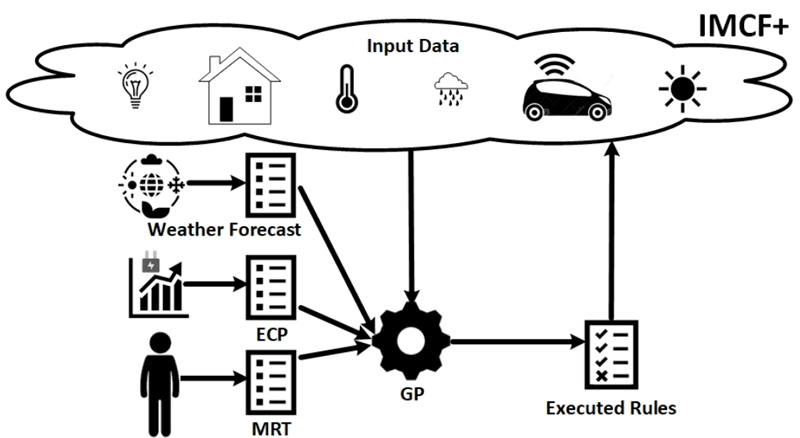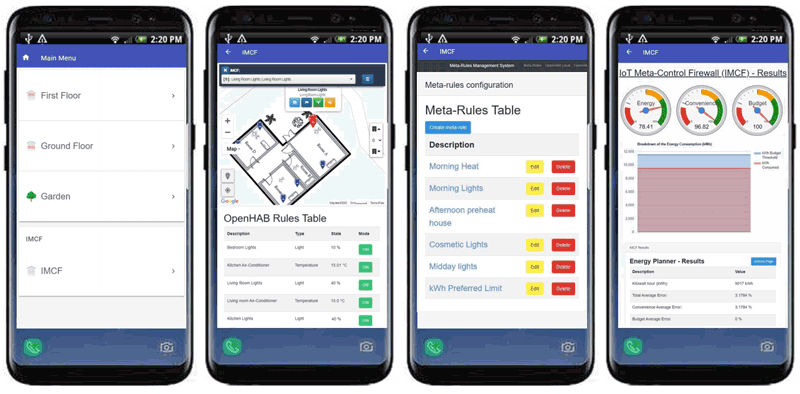by Soteris Constantinou (University of Cyprus, Cyprus), Andreas Konstantinidis (Frederick University, Cyprus) and Demetrios Zeinalipour-Yazti (University of Cyprus, Cyprus)
The advancement of renewable energy infrastructure, such as photovoltaic systems, in smart buildings has highlighted the importance of energy self-consumption – i.e., the process by which IoT-enabled, energy-demanding devices intelligently consume energy at the time it is available. In contrast, user comfort levels expressed in the form of Rule Automation Workflows (RAW) are usually not aligned with renewable production patterns. We have devised an innovative framework, coined IoT Meta-Control Firewall (IMCF+), which aims to balance the trade-off between comfort, energy consumption and CO2 emissions. The IMCF+ framework incorporates an innovative Green Planner (GP) algorithm, which is an AI-inspired algorithm that schedules energy consumption with a variety of amortization strategies, implemented as part of a complete IoT ecosystem in OpenHAB.
Eighty-five percent of all human CO2 emissions come from the burning of fossil fuels, such as coal, natural gas and oil. Almost half of global greenhouse gas emissions come from electricity and heat production (25%), transportation (14%) and buildings (6%), collectively. Most of the remainder is emitted by agriculture (24%), industry (21%) and other energy requirements (10%). Consequently, minimising CO2 pollution in spaces such as houses and offices, in which people spend 80 to 90% of their time, can help to ameliorate climate change.
A key driver for the control of CO2 is the uptake of Internet of Things (IoT), which connects all the smart devices in the world that are able to “see”, “hear”, “think”, “react”, perform tasks, and communicate with each other using open protocols, and thus, power consumption and CO2 emissions controlled by IoT infrastructure can be brought under the same roof. IoT makes it possible to develop smart applications in important domains that can have significant impacts on people’s quality of life and the growth of the world’s economy and security. A typical family in the developed world owns 5 to 10 internet-connected devices, such as smartphones, smart TVs and other smart-home devices, and according to Gartner [3] this number is expected to increase to more than 500 smart devices by 2022, and later on to 100 billion connected devices by 2030.
Rule Automation Workflows (RAW) aim to meet the comfort level of users under specific conditions (e.g., “warm house to 22 °C if cold, or preheat electric vehicle before departing”). In the simplest case, a user expresses preferences manually through a vendor-specific smartphone app/integrated app. This process requires continuous attention by custodians, making it a cumbersome process that generates erroneous executions and that clearly calls for more automated (i.e., “smarter”) approaches. Services like IFTTT, Apilio and Apple Automation expanded the expressiveness of the RAW with Boolean predicates (e.g., conjunctions) and even introduced procedural programming constructs, like variables, while loops, if statements and functions to advance RAW actuations. However, none of the above RAW technologies enables individuals or groups of users to express their comfort preferences while achieving a long-term objective.

Figure 1: The Green Planner (GP) algorithm proposed, is an AI-inspired algorithm that finds the best possible energy consumption strategy with respect to user comfort and CO2 emissions by only using a Meta-Rule-Table (MRT) profile, a Weather Forecast and an Energy Consumption Profile (ECP) and without the necessity of a learning history used by machine learning methods.
In IMCF+, a user (or group of users) starts out by defining a vector of RAW rules, named Meta-Rule Table (MRT), and an Energy Consumption Profile (ECP), as shown in Figure 1. The high-level objective is to identify among all MRT rules the ones that must be dropped so that the user stays within the desired energy budget according to the ECP history. For this purpose, it utilises an intelligent search algorithm, which goes over the exponentially large search space of numerous combinations, quickly yielding the rules to be dropped [1,2]. Particularly, IMCF+ adopts an intelligent energy amortization process along with an AI-inspired Green-Planner (GP) algorithm we proposed, to balance the trade-off between user comfort and CO2 emissions, subject to a pre-specified energy consumption budget, while satisfying the RAW pipelines of users. The amortization plan is responsible for calculating the maximum energy budget constraint and the CO2 emission constraint through a preselected amortization formula. Then an AI approach is executed to generate a green plan solution for optimizing the comfort error. IMCF+ adapts the RAW pipelines in such a way that these do not collide with the long-term objectives of users (by dropping certain rules based on preference priority). We have adopted a simulated annealing algorithm, which does not require a learning history (like respective machine learning techniques), does not require a target function (e.g., like A*), it does not get stuck in local optima (e.g., like traditional hill-climbing) and it is straightforward to implement in a resource-constraint setting like local smart controllers (e.g., Raspberry).
Our system architecture comprises a fully-fledged local controller implemented inside the Open Home Automation Bus (OpenHAB) stack, which is a smart home management software; and IMCF+, which is the software system that encapsulates the complete application logic of the energy management stack we proposed along with the respective user interfaces. For a pioneer integrated solution, we also made use of the Linux crontab daemon, the “Anyplace” for building modelling, as well as the Laravel PHP web framework following the model–view–controller architectural pattern (see Figure 2). The proposed system is protected by the authentication provided by OpenHAB and Laravel framework. The local controller is also located on the user’s local network and is protected by the Ubuntu operating system firewall. Therefore, the system is secure; anyone with malicious intent will have to break through the security offered by OpenHAB and Laravel to be able to infect files or penetrate the firewall.

Figure 2: IMCF+ Graphical User Interface: Integration of the IMCF+ Software Library in the OpenHAB Home Automation Stack. a) Interactive and Automated Menu; b) Dashboard for smart space current state linked with Anyplace Viewer; c) Meta-Rule-Table Configurator; and d) IMCF+ Results.
Given that our proposed framework requires no training data and only a primitive MRT preference profile, this can easily integrate in low end edge smart actuations platforms. We believe that by consuming energy more intelligently (i.e., green-smart IoT actuations) we can greatly reduce the environmental impact of ICT, enabling us to both improve living conditions and respect the environment, helping society to meet emissions reduction targets.
Link:
[L1] https://imcf.cs.ucy.ac.cy/
References:
[1] S. Constantinou et al.: “IMCF: The IoT Meta-Control Firewall for Smart Buildings”, in 2021 24th International Conference on Extending Database Technology (EDBT '21), pp. 658--661, OpenProceedings.org, 2021.
[2] S. Constantinou et al.: “The IoT Meta-Control Firewall”, in 2021 37th IEEE International Conference on Data Engineering (ICDE '21), pp. 12 pages, IEEE Computer Society, 2021.
[3] “Gartner - A Typical Family Home Could Contain More Than 500 Smart Devices by 2022” http://tiny.cc/4gk8tz
Please contact:
Demetrios Zeinalipour-Yazti
Data Management Systems Laboratory (DMSL)
Department of Computer Science
University of Cyprus
Tel: +357 22 892755
Figure 1: The Green Planner (GP) algorithm proposed, is an AI-inspired algorithm that finds the best possible energy consumption strategy with respect to user comfort and CO2 emissions by only using a Meta-Rule-Table (MRT) profile, a Weather Forecast and an Energy Consumption Profile (ECP) and without the necessity of a learning history used by machine learning methods.
Figure 2: IMCF+ Graphical User Interface: Integration of the IMCF+ Software Library in the OpenHAB Home Automation Stack. a) Interactive and Automated Menu; b) Dashboard for smart space current state linked with Anyplace Viewer; c) Meta-Rule-Table Configurator; and d) IMCF+ Results.










